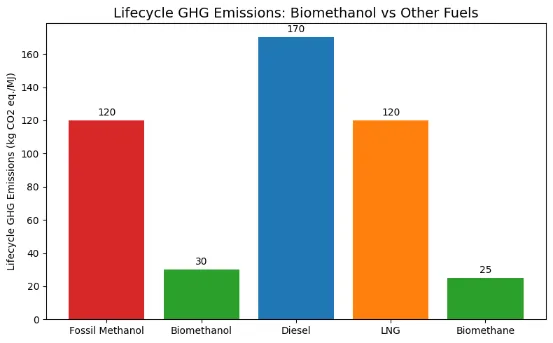The Science Behind Biomethanol: How It’s Made And Why It Matters
The Science Behind Biomethanol: How It’s Made And Why It Matters
What is Biomethanol?
Biomethanol is methanol made from renewable biomass sources instead of fossil fuels. Methanol itself is a simple alcohol (CH3OH) often used as a chemical feedstock, solvent, and more recently, as a transportation fuel. When produced from biomass, methanol becomes biomethanol, a sustainable liquid fuel that can greatly lower carbon emissions compared to traditional fossil fuels.
Unlike fossil methanol, which typically comes from natural gas or coal, biomethanol is made from organic waste, agricultural byproducts, wood, and other renewable resources. This renewable origin gives biomethanol a much smaller carbon footprint, making it important for reducing carbon emissions in shipping, road transport, and chemical manufacturing.
Why Biomethanol Matters
- Climate Benefits
Biomethanol can cut lifetime greenhouse gas emissions by up to 60-95% compared to fossil fuels, depending on feedstock and production methods. This makes it a useful tool for meeting international climate goals like the IMO’s 2050 target to halve shipping emissions and the EU’s Fit for 55 initiative. - Versatile Fuel
Biomethanol is a liquid at room temperature, which makes it easier to store, transport, and use than gaseous fuels like hydrogen or ammonia. It can be employed in existing or modified internal combustion engines and fuel cells, providing flexibility in operations. - Circular Economy
By using waste products such as agricultural residues, manure, and food waste, producing biomethanol encourages better waste management and creates value from materials that would otherwise decompose and emit methane, a strong greenhouse gas. - Energy Security
Biomethanol can be made locally from plentiful biomass resources, decreasing reliance on imported fossil fuels and improving energy security for many countries.
How Is Biomethanol Made? The Production Science
Making biomethanol involves turning biomass into a synthesis gas (syngas) mixture, which is then converted into methanol through catalysis. The main production methods are:
1. Biomass Gasification
Feedstock: Woody biomass, agricultural residues, municipal solid waste, and other plant materials.
Process: Biomass is heated at high temperatures (700-1000°C) in a low-oxygen environment to create syngas—a blend of carbon monoxide (CO), hydrogen (H2), and carbon dioxide (CO2).
Methanol Synthesis: The syngas is cleaned and introduced into a catalytic reactor where CO and H2 react under pressure to form methanol.
This thermochemical method is well-established and scalable, allowing for biomethanol production from various biomass sources.
2. Biogas Reforming
Feedstock: Biogas produced from the anaerobic digestion of manure, food waste, sewage sludge, and agricultural waste.
Process: Biogas (mainly methane and CO2) is purified and reformed (via steam reforming or partial oxidation) to produce syngas.
Methanol Synthesis: Similar catalytic conversion of syngas to methanol occurs next.
This method uses organic waste streams, enhancing waste management and cutting methane emissions from decomposition.
3. Hybrid Processes
Emerging technologies combine hydrogen (created through renewable electrolysis) with biogenic CO2 or syngas to produce biomethanol. This method can increase methanol yields and further decrease carbon footprints by utilizing green hydrogen.
Feedstocks for Biomethanol Production
The choice of feedstock is crucial for sustainability and economics. Common feedstocks include:
- Woody Biomass: Forestry leftovers, wood chips, and sawdust.
- Agricultural Waste: Straw, husks, corn stover.
- Organic Waste: Food waste, manure, sewage sludge.
- Municipal Solid Waste: Biogenic fractions suitable for gasification.
- Recycled Carbon: CO2 captured from industrial processes mixed with renewable hydrogen.
Using waste and residues avoids competition with food production and supports circular bioeconomy principles.
Technological Advances Improving Biomethanol Production
Recent improvements boost efficiency and output:
- Gasification Improvements: Advanced gasifiers that better remove tar and clean syngas.
- Catalyst Development: More durable catalysts that raise methanol yield and lower energy use.
- Hybrid Systems: The inclusion of renewable hydrogen enhances carbon utilization.
- Process Integration: Combining gasification, reforming, and methanol synthesis in optimized plants.
These improvements are making biomethanol production more affordable and scalable.
Environmental and Economic Benefits
Lifecycle Emissions Reduction
Biomethanol’s lifecycle emissions can be 60-95% lower than fossil methanol, based on feedstock and technology. By diverting waste from landfills and preventing methane emissions, it provides extra climate benefits.
Waste Management
Making biomethanol from organic waste streams cuts down on landfill use and related environmental issues like groundwater contamination and methane leakage.
Economic Opportunities
Biomethanol production creates jobs in rural areas, supports agricultural sectors, and encourages new industries focused on waste recovery.
Biomethanol in the Energy Transition
Shipping Fuel
Biomethanol is becoming popular as a marine fuel due to its low emissions and compatibility with dual-fuel engines. Major shipping companies are investing in methanol-powered vessels, backed by growing bunkering infrastructure.
Road Transport
When mixed with gasoline or used in dedicated engines, biomethanol can lower emissions in light and heavy-duty vehicles.
Chemical Industry
Biomethanol serves as a renewable feedstock to produce chemicals, plastics, and synthetic fuels, aiding the decarbonization of industrial sectors.
Challenges and Future Outlook
Feedstock Availability and Logistics
Large-scale biomethanol production requires sustainable biomass supply chains and efficient logistics to gather and process diverse feedstocks.
Cost Competitiveness
While costs are falling, biomethanol is still pricier than fossil fuels. Policy incentives, carbon pricing, and technological advancements will be essential for improving competitiveness.
Regulatory Support
Clear certification frameworks and supportive policies are necessary to encourage biomethanol use and maintain sustainability standards.
Conclusion
Biomethanol stands as a scientifically solid, environmentally sustainable, and economically promising fuel for a low-carbon future. By transforming renewable biomass and waste into a versatile liquid fuel, biomethanol tackles climate change, waste management, and energy security issues all at once. As technology improves and markets expand, biomethanol’s importance in the global energy transition will only grow, making it a crucial part of the clean energy puzzle.
Interested in Learning More About Renewable Fuels?
Subscribe to our newsletter for the latest insights on sustainable energy solutions and industry developments.
Subscribe Now
References & Sources
Trusted research and authoritative sources powering clean shipping innovation

